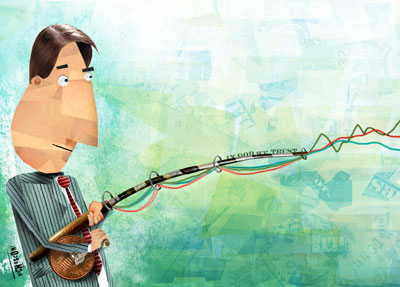Nearly everyone lost money in the recent market downturn. It was, by many measures, the toughest time for investors since the Great Depression. U.S. stocks tumbled
(a jaw-dropping, stomach-churning 57 percent at one point), foreign stocks tumbled, and corporate bonds tumbled. Just about everything else fell, and as a result, many investors—probably yourself included—saw their nest eggs shrink. Even though the past months have seen a bit of a comeback, investors are still scratching their heads, wondering if the old rules for investing still apply.
A rash of media stories called for abandoning the diversified portfolio, rejecting buy-and-hold investment, or adopting new tactics, such as market timing (jumping in and out of the stock market in the hopes of buying low and selling high) and cherry-picking (banking on one or possibly a handful of investments that you think will do better than all the others out there). Other stories have advocated just keeping your money under the proverbial mattress.
Investors are listening. According to the investment resource Morningstar, $573 billion in cash flowed into low-yielding but secure money-market funds in 2008 when the stock and bond markets (other than Treasury bonds) were suffering the most. As soon as the stock and bond markets started to come back in 2009, so did the investment money.
We’re here to tell you that you might want to think twice before following the pack and abandoning the tried and true—the well-diversified, broad portfolio of stocks and bonds and cash that you pretty much buy and hold—and jumping onto any bandwagon that promises to do better. Here’s why:
1. Cash is costly. Keeping your money in cash (money-market funds, savings accounts) may spare you from market volatility, but in the long run, the return on a diversified portfolio of 60 percent stocks and 40 percent bonds still clobbered cash. According to Morningstar, the respective 30-year returns on the diversified portfolio, after accounting for inflation, were three to four times that of a portfolio held in cash.
2. Markets are unpredictable in the short run. If you’re thinking that you’re going to keep your money in cash and pop into the markets at just the right time, think again. Pro investors often can’t even time the markets, says Cathy Pareto, MBA, CFP, president of Cathy Pareto & Associates, a wealth management firm based in Coral Gables, Florida. “Studies show that investors who buy and hold a diversified portfolio, rather than try to rush in and out of investments, tend to do much better.”
3. Specific winners and losers are unpredictable, too. If, instead of diversifying your portfolio, you try to zero in on individual securities or small segments of the market, you may be adding to your risk, but not your return. “People are often overconfident in thinking they can pick one stock or perhaps one industry that is going to do well,” says Don Bennyhoff, CFA, a senior investment analyst at Vanguard Investments. “Professional investors often do a very poor job when they attempt such picks—the average investor won’t even do that well.”
4. Costs are bigger than you think. When you buy and sell (whether popping in and out of the market, or gambling on individual stocks or market sectors) there are substantial costs involved, says Bennyhoff. The “spread” (the middleman’s cut) on stocks can be as high as several percentage points. There is often a commission or markup to pay the broker on any trade of a stock or bond, and fees on fund swaps are not uncommon. You may also pay higher taxes on a shifting portfolio than on a buy-and-hold one.
5. Look at the bottom line. The downturn of 2008–2009 was unusual in the manner in which so many investments, and entire classes of investments, turned sour at the same time. Still, diversification paid off, assures Bennyhoff. Bonds overall didn’t do quite so bad; some bonds, namely Treasuries, did very well. Certain segments of the stock market even shot off like rockets in the second half of 2009. Overall, if you had a highly diversified portfolio of 40 percent bonds, 30 percent U.S. stock, 20 percent foreign stock, and 10 percent cash, your portfolio on September 30, 2009, would have earned you 4.25 percent annually, or 51.63 percent cumulatively, over the prior decade. “Despite what you may have read, diversification and patience hasn’t entirely let us down,” says Bennyhoff.
Russell Wild, MBA, is a NAPFA-registered financial advisor who has written nearly two dozen books, including Index Investing for Dummies and Bond Investing for Dummies.
Become a Saturday Evening Post member and enjoy unlimited access. Subscribe now



